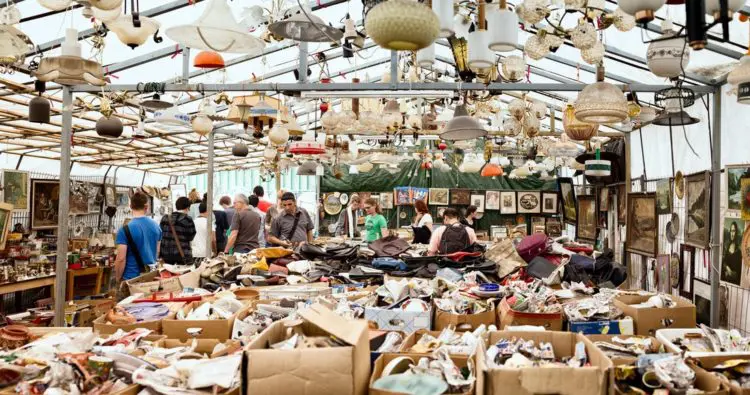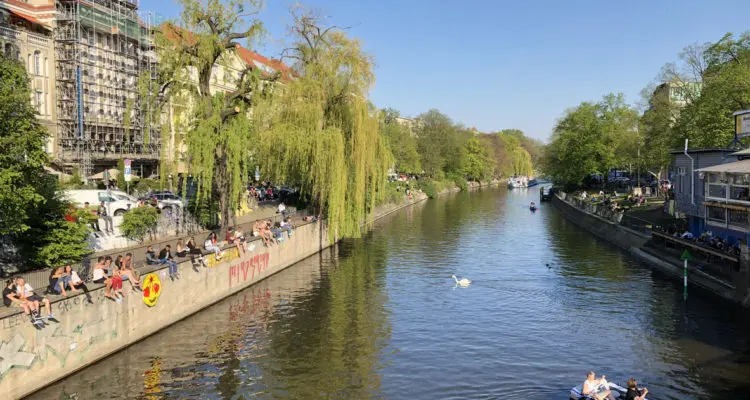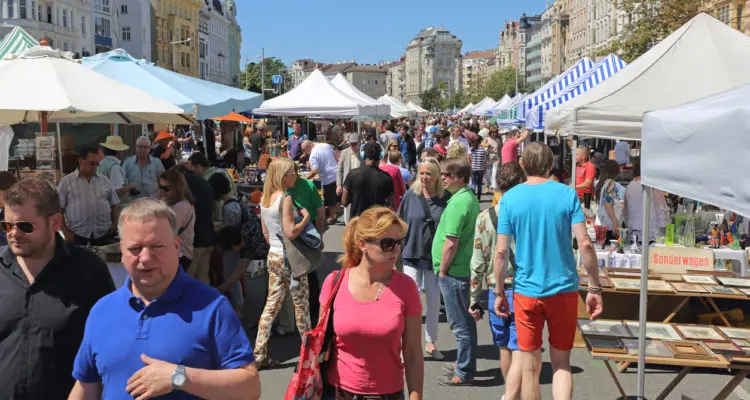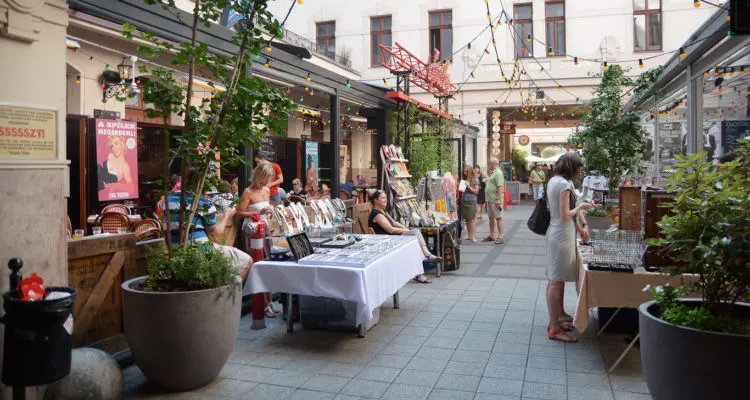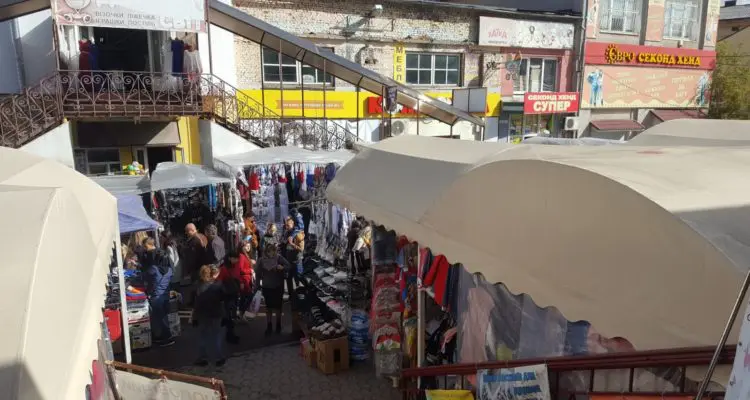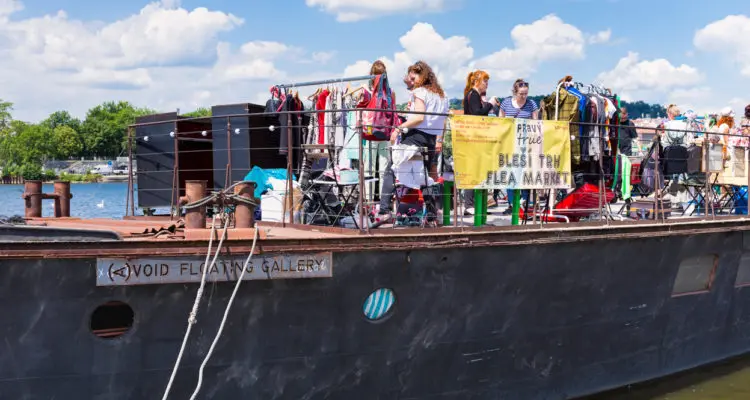Delve deep into local culture and history, and check out a flea market. From the banks of a canal, to a floating barge to market halls and pedestrian streets, East and Central Europe have endless opportunities for memorable, historic souvenirs, especially if you’re up for a bit of haggling. Here’s a sampling of haggling hotspots that we’re fond of visiting to hunt for curiosities.
Jump to a section of this article
Berlin
Berlin excels at weekly markets, which spring up in every neighborhood at least once a week. Some have a specialty, such as books, antiques, or Turkish food and textiles, while others are a bit more varied. Our local staff can recommend good markets close to your accommodations, but here are some local favorites spread out around the city center.
Mauerpark
We’d be remiss if we just skipped Mauerpark. Once covered by the Berlin Wall, Mauerpark (“Wall Park”) now hosts the city’s most popular flea market every Sunday. Located at the end of the Berlin Wall memorial strip, the market attracts some of the city’s most popular street food stands, while the park’s long grassy strip is home to a wide variety of buskers and picnicking locals. The park’s most unusual attraction is an amphitheater built into the side of a hill, famous for its karaoke sessions (starting at 3), with crowds of hundreds singing along (mostly in key). The city’s most touristy market, expect crowds and relatively high prices (though thankfully less mud than in years past due to belated renovation by the city). That said, there’s a reason for the place’s popularity, and visitors rarely leave without a treasure. Be sure to budget some time for relaxing in the park near your favorite busker.
Turkish Market
Perhaps the most popular market among locals, be sure to visit the Turkish Market (AKA the BiOriental Market, a three-way pun) if you’re in town on a Tuesday or Friday. Although you can find anything from scissors to cottage cheese, most of the vendors are Turkish, giving the market the air of a bazaar, down to dates and men wearing fezes and selling traditional Ottoman desserts. It’s easy to make a lunch out of a visit, perhaps combining prepared foods with bread, dips, deli items, and fruit from distant climes. This market stretches along the banks of the scenic Landwehr Canal near the border of Kreuzberg and Neukölln for several blocks. The eastern end attracts buskers, while the western end lies close to the Schönleinstrasse subway station.
Boxhagener Platz and the RAW Compound
These two separate locations are a mere five-minute walk apart, and are both worth hitting on a Sunday. Located in a former rail maintenance yard (RAW stands for the “National Railroad Maintenance Works”), this is a hip spot, known for its clubs and street art. On Sundays, you can find plenty of handmade pieces from local designers and artisans, in addition to international snacks, many vegan-friendly. You’ll see the area after you disembark from the Warschauer Strasse train station, just beyond the segment that’s still used for train repair. After you’ve had your fill, walk another block or two to the market at Boxhagener Plaza, or “Boxi.” You’ll find a wide range of wares on display here as well, with more of a focus on secondhand items, books, and LPs, as well as more street food. There are good cafes and restaurants in all directions (if you’ve seen Budapest, you might recognize Szimpla’s sister locations at both Boxhagener and RAW). If you’re hungry for more, head a block over to Shakespeare and Sons, an English-language bookstore known for its challah French toast on Sundays (and bagels the rest of the week). You can also gawk at Aufschnitt, a “butcher shop” where all the meat is made of textiles, or stop by Cafe Tasso, a charming book cafe surrounded by the famous architecture of Karl-Marx-Allee and Rigaer Strasse.
Vienna
Naschmarkt
Not just for food, the venerable Naschmarkt turns into a flea market with a wide variety of goods on offer every Saturday. A mix of professionals and everyday people, you can find valuable antiques along the kitsch and curious. Naturally, if you get hungry, take advantage of the market’s usual focus, foods of all kinds.
Budapest
Ecseri
Sure, you can find people selling old (or faux old) knickknacks along the pedestrian Dob Street in the Jewish District, but for the true flea market experience, hop on a bus or taxi to Ecseri, the city’s largest flea market. We also offer the possibility of visiting as part of a tour in a Communist-era Trabant. This is the place to go for finds that are authentic, fun, historic, and simply quite odd. Open daily, locals recommend visiting Saturday, when it’s busiest and vendors tend to have new items. It’s best to haggle the prices down, although the people selling items from their car trunks tend to have decent prices.
Falk Miksa Street
Although flashy Vaci Street has its fair share of antique shops, we recommend heading to the opposite end of the Parliament Building to Falk Miksa, the city’s antique row. With dozens of antique stores and galleries to choose from, this is the place for higher-end finds, or just a nice break from a downtown stroll. Despite its central location, this neighborhood is more laid-back, with a smaller version of the Great Market Hall, as well as calm cafes, and neighboring Margaret Island.
Jewish District
As you’d imagine, there is history for sale in the Jewish district. For fair prices and fun finds from the 60s and 70s, duck into Nostalgia Bazar. Nearby you’ll find Antik Bazar, with knick-knacks piled high for bargain seekers.
Lviv
Vernissage
We’ve got two favorite markets in Lviv, situated neatly at distant ends of the flea market spectrum. The Vernissage is a calm place to find traditional gifts, right by the opera house. Thanks to the cultural reawakening that followed the Maidan Revolution, traditional clothing, especially white shirts with colorful or red embroidery, have made a comeback. Ukrainian embroidery has even taken off abroad, showing up in fashion shows and streets throughout Europe, making for an excellent, useful, souvenir. The Vernissage also has plenty of handmade pieces by local artisans, such as the Gerdan bead jewelry distinctive to western Ukraine.
Krakivsky Market
The sprawling Krakivsky Market is more traditional and chaotic. Built on the site of a Jewish graveyard and hospital destroyed by the Nazis, you’ll find this warren of tents and buildings less than ten minutes northwest of the Vernissage, next to the Lvivarnya brewery and beer museum (which itself worth a visit). You’ll find absolutely anything here at cut-rate prices, often sold for extra income by retirees. Inside the colorful Soviet-era main hall, you’ll find plenty of produce and meat.
Krakow
Plac Targowy Unitarg
Krakow’s most popular outdoor market, Plac Targowy Unitarg (AKA Hala Targowa) is open daily, but is especially worth visiting on Sunday. The sheer variety of goods on offer is worth a visit alone, with everything available from an excellent selection of comics to Catholic icons, antiques, records, and shoes. Located between the Old Town and the Jewish District, this is a convenient location. If you’re hungry, return after 8 PM, when the vendors are replaced by a blue van selling the city’s best sausages.
Plac Nowy
Early on weekends, you can find another market at the center of Kazimierz, at Plac Nowy. Varied but more touristy, you can naturally find more Judaica and communist kitsch here. Come evening, the square becomes busy again, as locals and tourists alike flock to enjoy Zapiekanka, Krakow’s beloved open-faced sandwiches. Sautéed mushrooms, cheese, and other toppings are used to cover baguettes sliced in half lengthways, then covered with ketchup, sating the appetites of people spilling out from the district’s bars.
Prague
U Elektry
Although there are some pop-up flea markets on weekends, such as at Terminal Zizkov, we recommend heading for the outskirts, and visiting the largest flea market in the country, if not the continent (spanning 540,000 square feet), at U Elektry. Take a subway to the Hloubetin station, then the free shuttle bus marked “Blesi Trhy Praha,” which runs every 30 minutes on Saturday, and every 20 on Sunday (keep in mind that the market closes at 2). Items for offer run the gamut, from paintings and watches to tires and sausages. Since the market is located by a major road, you can board or taxi a streetcar at Republic Square at the eastern end of the Old Town, and arrive in 20 minutes or less (then stop at the Karlin district on the way back for good food and beer).
(A)VOID Floating Gallery
For something more pacific, head to the trendy neighborhood of Naplavka, near the foot of the Vysehrad fortress. On occasional Saturdays, you can visit a small flea market aboard the (A)VOID Floating Gallery (don’t let the name dissuade you!), a barge permanently moored on the river, with a nice view of Vysehrad and Prague Castle. The neighboring embankment is home to a popular farmer’s market on Saturdays, while the surrounding district is known for its cafes.
Our local staff will be happy to help you find memorable markets that work with your own itinerary. In addition, we have several tours that include time visiting markets open daily. Head to East and Central Europe, and you’re sure to return with plenty of memories, physical and otherwise.

Born and raised in Wisconsin, Kevin lived in Estonia and Finland for several years, traveling widely through Central and Eastern Europe, before settling down in Berlin. Having studied the cultures, histories, and economics of the countries along the Baltic Sea for his Master’s degree, Kevin has the knowledge and experience to help you plan the perfect trip anywhere in the region, and also works as JayWay’s main writer and editor.
